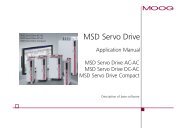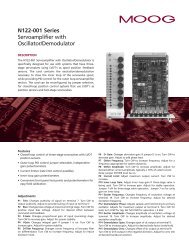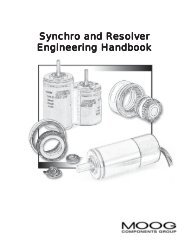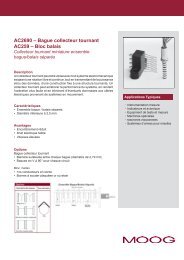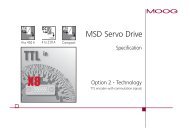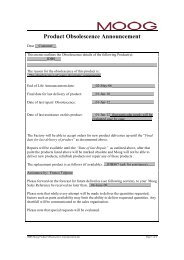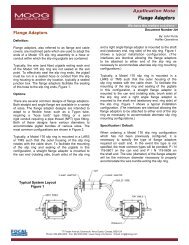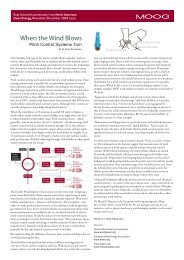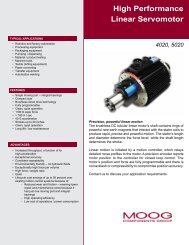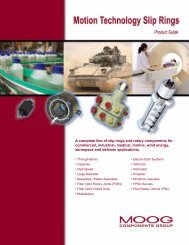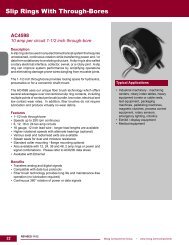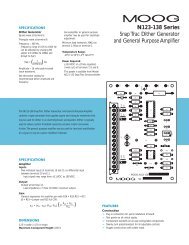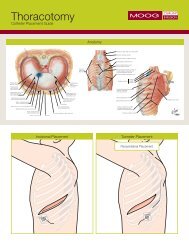D761 Series Servovalves
D761 Series Servovalves
D761 Series Servovalves
Create successful ePaper yourself
Turn your PDF publications into a flip-book with our unique Google optimized e-Paper software.
Service - worldwide<br />
Australia MOOG Australia Pty., Ltd · 14 Miles Street · MULGRAVE 3170, Vic.<br />
Telephone (03) 9561 6044 · Telefax (03) 9562 0246<br />
Brazil MOOG do Brasil Controls Ltda.· Rua Prof. Campos de Oliveira, 338,<br />
Santo Amaro · Cep 04675 - SÃO PAULO<br />
Tel: (011) 523 8011 · Fax: (011) 524 2186<br />
China MOOG Control System (Shanghai) Co. Ltd. · 458 Yu An Road · SHANGHAI 201 206<br />
Tel: (021) 5854 1411 · Fax: (021) 5854 1417<br />
England MOOG Controls Ltd. · Ashchurch · TEWKESBURY GL20 8NA<br />
Tel: (01684) 29 66 00 · Fax: (01684) 29 67 60<br />
France MOOG S.a.r.L. · 38, Rue du Morvan · Silic 417 · F 94573 RUNGIS<br />
Tel: (01) 45 60 70 00 · Fax: (01) 45 60 70 01<br />
Germany MOOG GmbH · Hanns-Klemm-Straße 28 · D-71034 BÖBLINGEN<br />
Tel: (07031) 622-0 · Fax: (07031) 622-100<br />
India MOOG Controls (I) Pvt. Ltd. · Plot 1,2 3 Electronic City · Hosur Road · BANGALORE 561 229<br />
Tel: (080) 8 52 05 85 · Fax: (080) 8 52 10 36<br />
Italy MOOG Italiana s. r. l. · Zona Industriale Sud D1 · Via dei 3 Corsi · I-21046 MALNATE (VA)<br />
Tel: (0332) 42 11 11 · Fax: (0332) 42 92 33<br />
Japan MOOG Japan Ltd. · 1532 Shindo · J-HIRATSUKA 254<br />
Tel: (0463) 55 36 15 · Fax: (0463) 54 47 09<br />
Korea MOOG Korea Ltd. · 505-4, Yeolmi-ri · Shilchon-myon, Kwangju-kun · KYUNGGI-DO<br />
Tel: (0347) 64 67 11 · Fax: (0347) 64 09 29<br />
Russia MOOG GmbH · Nizhegorodsky Filial · Ul. Chapaeva 43 · 606 130 PAVLOVO · Nizhegorodskaya Obl.<br />
Tel: (083171) 64540 · Fax: (083171) 64540<br />
Sweden MOOG Norden AB · Datavägen 18 · S-43632 ASKIM<br />
Tel: (031) 68 00 60 · Fax: (031) 28 75 32<br />
Spain MOOG s.a.r.l. · Poilgono Ubegun · Pabellón Altxerri · E-20810 ORIO<br />
Tel: (043) 13 32 40 · Fax: (043) 13 31 80<br />
USA MOOG Industrial Control Division · Plant 11 · Seneca and Jamison Road · EAST AURORA · NY 14052<br />
Tel: (0716) 655 3000 · Fax: (0761) 655 1615<br />
South Africa Winder Controls (Pty.) Ltd. · P. O. Box 383 · GERMISTON · 1400 South Africa<br />
Tel: (011) 873 4650 · Fax: (011) 873 4728<br />
8<br />
Australia Melbourne<br />
Austria Vienna<br />
Brazil São Paulo<br />
China Shanghai<br />
China Hong Kong<br />
England Tewkesbury<br />
Finland Helsinki<br />
France Rungis<br />
Germany Böblingen<br />
India Bangalore<br />
Ireland Ringaskiddy<br />
Italy Malnate (VA)<br />
Japan Hiratsuka<br />
Korea Kwangju<br />
Philippines Baguio<br />
Russia Pavlovo<br />
Singapore Singapore<br />
Spain Orio<br />
Sweden Göteborg<br />
USA East Aurora (NY)<br />
MOOG GmbH<br />
Hanns-Klemm-Straße 28<br />
D-71034 Böblingen<br />
Postfach 1670<br />
D-71006 Böblingen<br />
Telefon (07031) 622-0<br />
Telefax (07031) 622-191<br />
SERV <strong>D761</strong> - EN / 07.99<br />
KRH/KRH/50 · Printed in Germany<br />
Technical changes are reserved<br />
<strong>Servovalves</strong><br />
<strong>D761</strong> <strong>Series</strong><br />
ISO 10372 Size 04<br />
Operating<br />
Instructions<br />
1
<strong>D761</strong> <strong>Series</strong><br />
Table of Contents<br />
1. Safety Instructions page 2<br />
2. Description page 3<br />
3. Installation page 4<br />
4. Setting up page 5<br />
5. Maintenance page 6<br />
6. Malfunctions, Causes and Elimination page 6<br />
7. Declaration of Manufacturer page 6<br />
8. Tools, Spare Parts and Accessories page 7<br />
1. Safety Instructions<br />
1.1 Warnings and symbols<br />
1.2 Correct application<br />
2<br />
refers to special orders and prohibitions to prevent<br />
damage<br />
refers to special orders and prohibitions to<br />
prevent injury or property damage<br />
1.2.1 The valves series <strong>D761</strong> are control valves suited for<br />
electrohydraulic position-, velocity-, pressure- and force control.<br />
The valves are designed for flow rate control in hydraulic<br />
systems that operate with mineral oil based fluids. Others<br />
on request.<br />
Using the valves for purposes other than those mentioned<br />
above is considered contrary to the intended use. The user<br />
bears entirely the risk of such misuse.<br />
Correct application involves also observing the operating<br />
instruction and complying with the inspection and<br />
maintenance directives.<br />
1.3 Organizational measures<br />
1.3.1 We recommend to include this operating instruction into<br />
the maintenance plan of the machine / plant.<br />
1.3.2 In addition to the operating instruction, observe also all<br />
other generally applicable legal and other mandatory<br />
regulations relevant to accident prevention and environmental<br />
protection. Instruct the operator accordingly.<br />
1.3.3 All safety and danger prevention instructions of the<br />
machine/plant must meet the requirements of EN 982.<br />
1.4 Selection and qualification of personnel<br />
1.4.1 Only well-trained and instructed personnel are allowed to<br />
work with MOOG control valves.<br />
P A T B X<br />
Torquemotor<br />
Feedback<br />
wire<br />
Amplifier<br />
Spool<br />
Bushing<br />
Filter<br />
1.4.2 Work with electrohydraulic valves must be carried out only<br />
by personnel having special knowledge and experience in<br />
plants running with electrohydraulic controls.<br />
1.5 Safety instructions for specific operational phases<br />
1.5.1 Take the necessary precautions to ensure that the machine/<br />
plant is used only when in a safe and reliable state.<br />
1.5.2 Check the machine/plant at least once per working shift<br />
for obvious damage and defects (i.e. leakage). Report any<br />
changes to the responsible group / person immediately. If<br />
necessary, stop the machine immediately and secure it.<br />
1.5.3 In the event of malfunctions, stop the machine/plant<br />
immediately and secure it. Have any defects rectified immediately.<br />
1.5.4 If the machine/plant is completely shut down for maintenance<br />
and repair work at the valve, it must be secured<br />
against inadvertent start up by:<br />
❒ Locking the principal control elements and removing<br />
the key.<br />
❒ attaching a warning sign to the main switch.<br />
1.6 Safety instructions for the operation of hydraulic<br />
plants<br />
1.6.1 Work on electrohydraulic equipment must be carried out<br />
only by personnel having special knowledge and experience<br />
in electrohydraulic controls.<br />
1.6.2 Check all lines, hoses and fittings of the plant regularly for<br />
leaks and obvious damage. Repair damage immediately.<br />
Splashed oil may cause injury and fire.<br />
1.6.3 Before removing the valve depressurize all system sections<br />
to be opened, pressure lines and accumulators of the<br />
hydraulic system in accordance with the specific instructions<br />
for the plant.<br />
1.6.4 When handling oil, grease and other chemical substances,<br />
observe safety regulations valid for each product.<br />
<strong>D761</strong> <strong>Series</strong><br />
8. Tools, Spare Parts and Accessories<br />
8.1 Tools<br />
Tools are only required for for installation, nulladjustment<br />
and filter replacement.<br />
8.1.1 Installation of the valve<br />
8.1.1.1 Mounting of the valve requires Allan wrench SW 6<br />
8.1.2 Nulladjustment<br />
8.1.2.1 For jam nut, cranked ring wrench 3/8"<br />
8.1.2.2 For adjustor pin, Allan wrench 3/32"<br />
8.1.3 Filter replacement<br />
8.1.3.1 For removal and mounting of the cover,<br />
Allan wrench SW 3<br />
8.1.3.2 For extraction of the filter disk use of a scriber or small<br />
screw driver is suggested.<br />
8.1.3.3 For mounting the o-ring on the cover and for inserting<br />
o-rings into the valve base clean grease is required.<br />
For valves having EPDM o-rings (Letter E in type designation)<br />
normal grease must not be used.<br />
Instead use special grease (LUBRICANT MOOG NO. A22596).<br />
8.2 Spare Parts<br />
MOOG Part No. Description Pos. 1 ) Dimensions Material Qty.<br />
42082 022 O-ring, ports P, T, A, B, ID 10,2 x Ø 1,78 FPM Sh 85 4 pcs.<br />
42082 013 O-ring, port X ID9,25 x Ø 1,78 FPM Sh 85 1 pc.<br />
A67999 065 Replaceable filter disk 13 65 µm nominal 1 pc.<br />
A25163 013 015 O-ring, for filter change 58 ID 13 x Ø 1,5 FPM Sh 85 2 pc.<br />
66098 040 006 set screw, port X (internal/external) M4 x 6 DIN EN ISO 4762-8.8 1 pc.<br />
A25528 040 Seal ring, port X ID 4,5 / AD 7 1 pc.<br />
1 ) see sketch chapter 5.1, Filter replacement, page 6<br />
8.3 Accessories (not included in delivery)<br />
8.1.4 Assembly of crimp contacts of the connector<br />
as per descripton section 3.3.1 on page 4<br />
Item Qty. Description MOOG Part No.<br />
1 1 Crimp pliers C21162 001<br />
2 1 Positioner, tool insert<br />
for contact sizes<br />
16 und 20<br />
C21163 001<br />
3 1 Installation tool<br />
for contact size 16<br />
C21164 001<br />
4 1 Replacement tool<br />
for contact size 16<br />
C21165 001<br />
The complete tool set for crimping can be obtained from<br />
MOOG by ordering part no. C21166 001.<br />
MOOG Part No. Description Dimensions / Notes Qty.<br />
B46744 004 Mating connector, 4-pole, Mil C5015/14S-2S<br />
(for cable dia min 6,5 mm, max 9,5 mm)<br />
waterproof, protection IP65<br />
A03665-080-045 Mounting bolts M8x45 DIN EN ISO 4762-10.9 4 pcs.<br />
Mounting manifold see special data sheet<br />
55127 001 Flushing plate (for internal pilot supply)<br />
55127 002 Flushing plate (for external pilot supply)<br />
Our quality management system<br />
is certified in accordance with<br />
DIN EN ISO 9001<br />
7
<strong>D761</strong> <strong>Series</strong><br />
6<br />
Note: Turn adjustor only slightly!<br />
Do not turn the adjustor more than one quarter turn in<br />
either direction (± 20 degrees is equivalent to ± 10% null<br />
shift).<br />
4.3.2 While adjusting watch the actuator (motor) motion to find<br />
the null position. With overlapped valves turn the adjustor<br />
carefully in both directions to just start motion and then<br />
back into deadzone midposition between those two wrench<br />
positions.<br />
4.3 .3 After proper nulladjustment hold the adjustor with the<br />
3/32" Allan wrench and lock jam nut by tightening it to<br />
7 Nm with the 3/8" ring wrench.<br />
Mount the mating connector again.<br />
4.4 Setting up<br />
4.4.1 Set up machine / plant according to the operation instructions<br />
of the manufacturer after the valve has been installed.<br />
Vent hydraulic system!<br />
4.4.2 The safety instructions of the machine / plant manufacturer<br />
must be observed.<br />
4.4.2 Observe oil temperature.<br />
4.4.3 Check hydraulic system for external leakage!<br />
5. Maintenance<br />
Besides regular visual inspection for external leakage and<br />
filter replacement, valve maintenance work is not required.<br />
All repairs of MOOG valves can only be performed at<br />
facilities listed in MOOG World Wide Service Network<br />
(see back cover).<br />
5.1 Filter replacement<br />
The built-in filter disk protects orifices and nozzles against<br />
coarse contaminants. With severe contamination the valve<br />
response will be slowed down.<br />
Replace filter!<br />
Before starting to work on the valve clean the external<br />
surface around the filter cover!<br />
Attention: The filter disk (13) is flown from inside to the<br />
outside. After removal of the cover (8) any contamination<br />
particles are at the inside of the<br />
disk (13) and therefore can not<br />
be seen from outside.<br />
5.1.1 Remove 4 internal hex bolts<br />
(34) using Allan wrench<br />
(SW3). Remove cover (8).<br />
Remove the filter disk (13)<br />
now accessible by using a<br />
scriber or a fine screwdriver<br />
as extraction tool.<br />
5.1.2 Check o-rings (58) and (59)<br />
for damage. Replace if necessary.<br />
5.1.3 Insert o-ring (58) behind the filter disk first. Then insert the<br />
new filter disk (13) such that the side with the notch at the<br />
rim points outward. Mount the second o-ring (58) on the<br />
cover (8) using clean grease and mount cover to the valve<br />
body. Torque the 4 bolts (34) to 4 Nm.<br />
5.1.4 Check valve for external leakage after pressurizing it.<br />
6. Malfunctions, Causes and<br />
Elimination<br />
For trouble shooting <strong>D761</strong> - <strong>Series</strong> valves use of MOOG<br />
Valve Tester Model B96634 is suggested. See Operation<br />
Instruction “MOOG Valve Tester”<br />
6.1 Leakage at the mounting surface of the valve<br />
❒ Have all seals been installed properly at ports A, B, P, T<br />
and X?<br />
❒ Have the mounting bolts been tightened correctly?<br />
Pay attention to the required torque!<br />
Tighten bolts diagonally changing!<br />
6.2 No hydraulic response of the valve<br />
❒ Check coil resistance using an Ohmmeter.<br />
(see page 5 for values).<br />
❒ Check for electric input signal.<br />
❒ Check the mating connector for corrosion!<br />
❒ Is hydraulic pressure present?<br />
❒ Is the filter disk contaminated?<br />
❒ Check pilot supply. Do you need internal or external?<br />
❒ Is pilot pressure present?<br />
6.3 Instability of the system, plant oscillates<br />
❒ Check whether input signal is stable.<br />
❒ Check filter disk for contamination.<br />
6.4 At zero command signal the load drifts slowly<br />
(open loop)<br />
❒ Adjust valve null according to 4.3<br />
6.5 With hydraulics ON valve goes hardover<br />
Orifice contaminated (plugged).<br />
Send valve to MOOG service center.<br />
7. Declaration of Manufacturer<br />
A Declaration of Manufacturer according to EC machine directive<br />
98/37/EG is available for servo valves <strong>D761</strong> <strong>Series</strong> and will be<br />
supplied upon request.<br />
<strong>D761</strong> <strong>Series</strong><br />
2. Description<br />
<br />
2.1.1 General<br />
The <strong>D761</strong> <strong>Series</strong> servo valves are throttle valves for 3- and<br />
preferably 4-way applications. They consist of an electromechanical<br />
transformer (torque motor), a hydraulic<br />
amplifier (nozzle/flapper principle), a spool in a bushing<br />
and a cantilever feedback spring. The torque motor contains<br />
coils, pole pieces, permanent magnets and an<br />
armature. The armature is connected to a flexible tube<br />
which allows a limited rotation of the armature and at the<br />
same time seals the electromagnetic components against<br />
the hydraulic fluid.<br />
The hydraulic amplifier is a full bridge arrangement with two<br />
upstream fixed orifices and two downstream variable orifices<br />
created by two nozzles and a flapper between them. The<br />
flapper is connected at its upper end to the centre of the<br />
armature and extends downward through the flexure tube to<br />
the nozzles. A deflection of the flapper between the nozzles<br />
changes the size of the variable orifices in opposite sense.<br />
2.2 Technical data<br />
The 4-way spool controls fluid flow from pressure port to<br />
one of the load ports and also from the other load port to<br />
return.<br />
Deflection of the feedback spring due to spool displacement<br />
produces a torque which is fed back to the torquemotor.<br />
2.1.2 Operating principle<br />
An electric current (command or input signal) is applied to<br />
the coils of the torquemotor and produces depending on<br />
the current polarity a clockwise or counterclockwise torque<br />
to the armature. The thereby deflected nozzle flapper<br />
system creates a pressure difference across the drive areas<br />
of the spool and effects its movement. The feedback spring<br />
connected to the armature engages with its lower end into<br />
a slot of the spool and is thus deflected by spool displacement.<br />
The motion of the spool stops when feedback<br />
torque and electromagnetic torque are in equilibrium. Then<br />
the flapper is again in hydraulic centre position (approximately).<br />
Thus the position of the spool is proportional to<br />
the electric command signal.<br />
<strong>Series</strong> <strong>D761</strong>- .....S..... <strong>D761</strong>- .....H.....<br />
Mounting pattern ISO 10372 - 04 - 04 - 0 - 92 ISO 10372 - 04 - 04 - 0 - 92<br />
Pilot connection optional, internal or external optional, internal or external<br />
Mounting direction any, fixed or movable any, fixed or movable<br />
Vibration 30 g, 3 axes 30 g, 3 axes<br />
Mass [kg] 1 1<br />
Rated flow Q N [l/min] see nameplate of the valve see nameplate of the valve<br />
at p N = 35 bar per land, tolerance ±10 %<br />
Max. valve flow Q max [l/min] 120 80<br />
Null leakage flow 1 ) total, max. [l/min] 1,1 to 2,0 1,4 to 2,3<br />
Null leakage flow 1 ) pilot stage only [l/min] 0,45 0,7<br />
Pilot flow 1 ) max, at 100% step input [l/min] 0,2 0,3<br />
Max. operating pressure p max<br />
ports P, X, A, B [bar] 315 (350 bar upon request) 315 (350 bar upon request)<br />
port T [bar] 210 210<br />
Temperature range Ambient [°C] – 20 to + 60 – 20 to + 60<br />
Fluid [°C] – 20 to + 100 – 20 to + 100<br />
Operating fluid mineral oil based hydraulic fluid according to DIN 51524,<br />
part 1 to 3, others upon request<br />
Viscosity recommended [mm²/s] 15 to 100 15 to 100<br />
System filtration High pressure filter, mounted in the main flow without bypass,<br />
but with dirt alarm<br />
Class of cleanliness according to<br />
ISO 4406 for normal operation 14 / 11 14 / 11<br />
for longer life 13 / 10 or better 13 / 10 or better<br />
NAS 1638 for normal operation 5 5<br />
for longer life 4 or better 4 or better<br />
Filter rating for normal operation 10 75 (10 µm absolute) 10 75 (10 µm absolute)<br />
for longer life 5 75 (5 µm absolute) 5 75 (5 µm absolute)<br />
1) At 210 bar pilot or operating pressure, fluid viscositiy<br />
of 32 mm²/s and fluid temperature of 40°C<br />
For additional technical information,<br />
such as dimensions, ordering information<br />
etc. see catalogue <strong>D761</strong> <strong>Series</strong>.<br />
3
<strong>D761</strong> <strong>Series</strong><br />
3. Installation<br />
3.1 General Information<br />
3.1.1 Compare model number and valve type with information<br />
from the hydraulic schematic or bill of material.<br />
3.1.2 The valve can be mounted in all directions, fixed or moveable.<br />
3.1.3 Check mounting surface for planeness (0,02 mm for<br />
100 mm) and surface roughness (Ra



